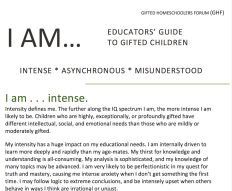When we began as a nonprofit startup, we sought seed funding to launch our program. But even from the earliest days, we received requests from families with children whose needs are so acute that they aren’t being met by the school system.
These are families who don’t have the resources to do what wealthier families with extremely asynchronous children do, and either “afterschool” or homeschool their children. Their children are suffering immensely because their educational, social, and emotional needs are not being met. Their families are similarly suffering from the fallout. We wish we were already up and running, so that we could ask these families to apply formally for support, and so we could then provide that support.
The program model the Asynchronous Scholars’ Fund advocates for, is based on a support approach proven successful by thousands of families across the United States (and internationally, even more families) over the course of the past twenty-plus years, and indeed for decades before that.
What does it look like? The details may vary somewhat depending on whether a child is in school, or homeschooled. The basic approach is this: Let the child follow his or her interests. The parent(s) serve as facilitators, providing materials, books, videos, classes and workshops, outings, and projects to allow the child to study the topic in question with as much depth as he or she desires, for as long as desired. Typically the child will move on to the next topic when the first one has been exhausted. Some children, particularly the more exceptionally and profoundly asynchronous, may have multiple interests they explore in depth simultaneously.
How can any child cover a full curriculum this way, particularly if learning exclusively in a home setting? The answer is anchored in who these children are. Most will branch out to end up exploring the full range of what typical children would cover in school, out of sheer interest. Most do so on their own schedule; while some maintain their learning multiple, ever-increasing grade-levels ahead across the board, others will reach a point when they realize that to achieve something they want and need – perhaps community college early admission, for example – they have to meet state requirements for high school graduation or equivalency, and will cram the needed learning into a very short time period.
Other kids, especially those with twice exceptionalities like dyslexia or Asperger’s spectrum disorder, may require more parental guidance to support and strengthen their weak areas, while they soar ahead in their strengths. Some may require remediation using approaches that can be adopted by the facilitating parent, but others require additional outside support from occupational therapists and other professionals.
Additionally, children with narrow interests may need parents to weave that interest into everything they do. If the love is horses, for example, that provides the opportunity to do horse math: If you have three horses in the stable, but six stalls, what percentage of stalls are filled? Horse grammar: What part of speech is the word “horse”? What is the etymology of the various horse part names? Horse biology! The physics of horse motion! The possibilities are nearly endless.
For asynchronous kids who are in a school, the degree of after-school and weekend accommodation will depend deeply on the accommodation that is happening during school hours. Is the child accelerated to the level of his or her intellectual age? Is the curriculum compacted to meet his or her need for learning at a faster pace? Does the child have intellectual (not chronological age) peers? If these needs are met, the needs out of school will be less intense.
But an asynchronous child whose needs are not being met in school will have extremely intense needs after school and on weekends. Most families in this situation find they need to devote constant effort to feeding the “lion” that is the child’s ravenous intellect. Because the social and emotional well-being of these children is closely tied up in having their intellectual needs met, families trying to use afterschooling to meet all these needs have a much harder time. It can be done successfully, but most success results from a combination of advocacy to have the child’s needs met in school through acceleration to place the child with intellectual peers, curriculum compaction, and in-school enrichment, in addition to the intensive afterschooling efforts.
The Asynchronous Scholars’ Fund advocates for organizations, community groups and the education sector to provide direct aid to families in need to help their asynchronous and twice-exceptional children. Support should include provision of services like assessments and advocacy through service partners familiar both with the needs of gifted children, and the methods of school districts, schools and educators. It should include the provision of intensive educational resources specifically tailored to each child’s needs. Kids and families may require individual or family counseling from specialists experienced in working with this population. Families should have access free and low-cost online resources, including, when needed, through the provision of computer technology, training, and Internet access. And because community can be the greatest support network for anyone, the Fund aims to help families connect with existing communities of families with kids like theirs, both online and in person.
Stay tuned for our next blog post on the the reasons why parents meet resistance from their own families, communities and schools in seeking to meet their children’s needs by following this model, and how they can help resolve that challenge.
 Have a kid like
Have a kid like  Perhaps most of all, it is critical to find intellectual peers for your child. It doesn’t matter what age the peers are, although if you can find age peers who are also intellectual peers, that’s even better. Knowing others like them can be critical to 2e kids’ ability to cope with how different they are; finding true peers will help them deal with their challenges and celebrate their joys.
Perhaps most of all, it is critical to find intellectual peers for your child. It doesn’t matter what age the peers are, although if you can find age peers who are also intellectual peers, that’s even better. Knowing others like them can be critical to 2e kids’ ability to cope with how different they are; finding true peers will help them deal with their challenges and celebrate their joys. As an individual, I volunteer for GHF as part of their professional outreach team. They recently asked me to write another brochure for them following on the success of the
As an individual, I volunteer for GHF as part of their professional outreach team. They recently asked me to write another brochure for them following on the success of the  I don’t usually write posts from my own point of view, but I recently helped
I don’t usually write posts from my own point of view, but I recently helped
You must be logged in to post a comment.